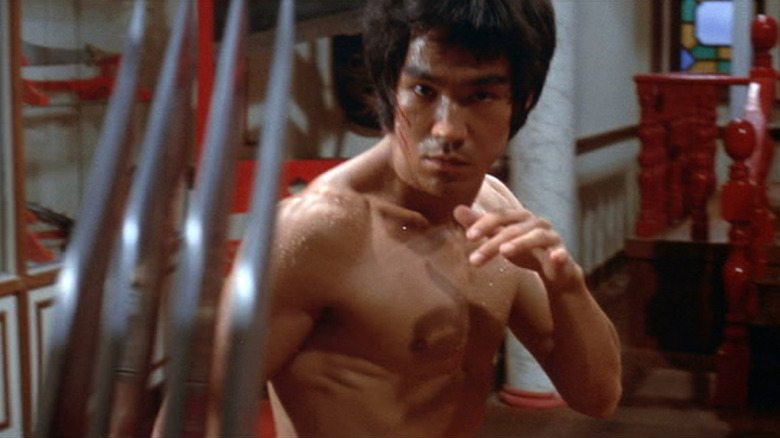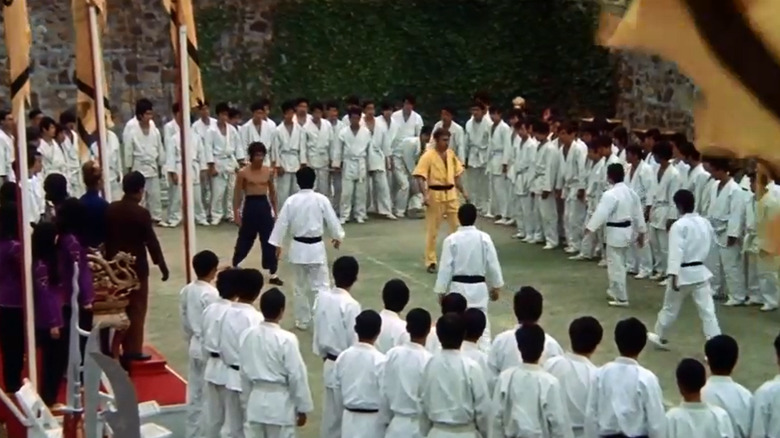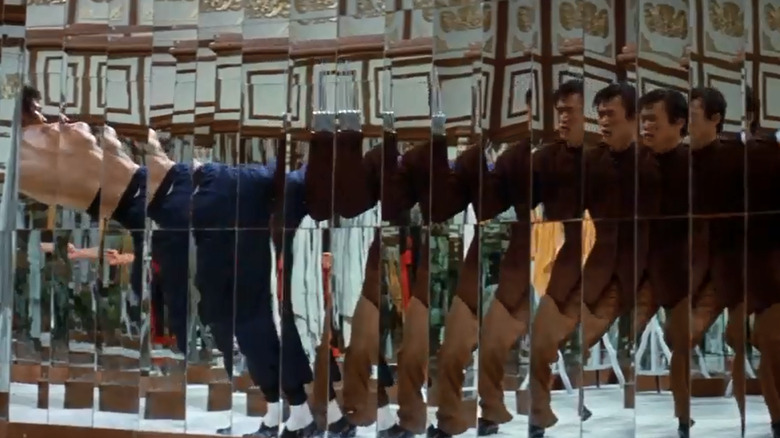
By modern standards, Hong Kong martial arts megastar Bruce Lee was built for Hollywood. But the early 1970s was a much different time from today. Lee desperately tried to become a star in the U.S. but Hollywood wasn't ready for a Chinese action star. When the stars finally did align for the actor with "Enter the Dragon," fate would have other plans. The 1973 film meant to introduce Bruce Lee to American audiences would sadly be his last completed work before the martial arts phenom's untimely death. Before he left us, Lee's final on-screen work left its mark on American cinema both on-screen and off it.
The film about a martial arts instructor who infiltrates a drug lord's fortress through a martial arts tournament to avenge his sister's death was made for less than $1 million and became one of the most successful martial arts films of all time. It also made martial arts an overnight sensation in America, inspiring a wave of martial arts films, while paving the way for foreign actors. And yet, it might surprise you that the man behind the camera for "Enter the Dragon" didn't even know the industry term for widescreen before production began. That didn't stop him from capturing one of the most memorable fight sequences in martial arts movie history.
'He Was Shooting Anamorphic, But I Didn't Even Know What That Was'

According to Collider, the 40th anniversary Blu-ray of "Enter the Dragon" features a Q&A with many involved with the movie, including Warner Bros. producers Fred Weintraub and Paul Heller. In the session, they reveal the unlikely story of how Lee made it to Hollywood. In the early 1970s, Weintraub looked at old Chinese films for new ideas and was enthralled by the fight sequences at the end of the movies "when the guy in white comes out and destroys five hundred guys in black all by himself."
That led the pair to Lee, who was already a Hong Kong martial arts film legend and martial arts trainer to Hollywood stars. Lee had dabbled in Hollywood previously with little success. He appeared on the short-lived TV show "The Green Hornet," but his only other English-speaking film was 1969's "Marlowe," and he lost out on the role of Kwai Chang Caine in the TV series "Kung Fu." Making any American production with Lee was difficult because, as Weintraub explains, in 1973, "Never had a Chinese man been played by an actual Chinese."
Weintraub and Heller continued relentlessly and finally secured enough international funding to produce "Enter the Dragon." Although set in Hong Kong, the movie featured two established American stars, John Saxon and Jim Kelly, and conventions similar to a James Bond film to make it seem more familiar to American audiences. While Lee was perfect for the role, the same couldn't be said about rookie cinematographer Gil Hubbs. In recalling his conversation with director Bob Clouse, Hubbs said:
"He was shooting anamorphic, but I didn't even know what that was. I had my American Cinematheque manual on the plane and I had to look up anamorphic, that means it's widescreen."
Although Hubbs had only done commercials and documentaries up to that point, he was about to help capture Lee's most captivating fight sequence in his entire film catalog.
The Lasting Legacy Of Enter The Dragon
 pdir="ltr">ThemirrorsequenceinvolvesafightbetweenLeeandthefilm'santagonist,Han(KienShih)inaroomfullofmirrors.Thereflectivesurfacessurroundingthecrewprovedtobealogisticalnightmarebecausethecameracouldbeseenregardlessofwhereitwasplaced.HubbscreditsdirectorBobClousewithcomingupwithasolution:/p>blockquote>"Bob'sideawas,sothatwewouldn'tbeseen,tobuildaclosetandputmirrorsontheoutsideofit.WewouldputthecameraintherewithmeandBobandtheassistant.Wecutacoupleofholes.Ifwewantedthecamerahere,wewouldmovetheclosetto[getthatangle]andjuststickthelens[throughthehole]."/blockquote>pdir="ltr">Theresultwasafightscenestillreveredtodayasoneofthebestinfilmhistory./p>pdir="ltr">[embed=https://www.youtube.com/watch?v=KybPsLcInso]/p>pdir="ltr">"EntertheDragon"wouldbeahugehitbothintheU.S.andinternationally.Unfortunately,thesuccessofthefilmwasshroudedbythedeathofLeejustbeforethefilm'sreleasewhentheactorsufferedanallergicreactiontopainkillers.AsPaulHellerremembers,"InevermetanyoneinmylifethatwantedtobeastarmorethanBruce."ThoughLeehadfinallyaccomplishedhisdream,itwouldbeposthumously./p>pdir="ltr">Thelegacyof"EntertheDragon"mightbeforrepresentationasmuchasitisforitsepicmirrorsequence.BruceLeewasabletodosomethingotherscouldneverdo,makeAmericanaudiencesinterestedinaChinesemanplayingaChineseman.It'sashamehewasn'taroundtoseeit./p>
pdir="ltr">ThemirrorsequenceinvolvesafightbetweenLeeandthefilm'santagonist,Han(KienShih)inaroomfullofmirrors.Thereflectivesurfacessurroundingthecrewprovedtobealogisticalnightmarebecausethecameracouldbeseenregardlessofwhereitwasplaced.HubbscreditsdirectorBobClousewithcomingupwithasolution:/p>blockquote>"Bob'sideawas,sothatwewouldn'tbeseen,tobuildaclosetandputmirrorsontheoutsideofit.WewouldputthecameraintherewithmeandBobandtheassistant.Wecutacoupleofholes.Ifwewantedthecamerahere,wewouldmovetheclosetto[getthatangle]andjuststickthelens[throughthehole]."/blockquote>pdir="ltr">Theresultwasafightscenestillreveredtodayasoneofthebestinfilmhistory./p>pdir="ltr">[embed=https://www.youtube.com/watch?v=KybPsLcInso]/p>pdir="ltr">"EntertheDragon"wouldbeahugehitbothintheU.S.andinternationally.Unfortunately,thesuccessofthefilmwasshroudedbythedeathofLeejustbeforethefilm'sreleasewhentheactorsufferedanallergicreactiontopainkillers.AsPaulHellerremembers,"InevermetanyoneinmylifethatwantedtobeastarmorethanBruce."ThoughLeehadfinallyaccomplishedhisdream,itwouldbeposthumously./p>pdir="ltr">Thelegacyof"EntertheDragon"mightbeforrepresentationasmuchasitisforitsepicmirrorsequence.BruceLeewasabletodosomethingotherscouldneverdo,makeAmericanaudiencesinterestedinaChinesemanplayingaChineseman.It'sashamehewasn'taroundtoseeit./p>
Read this next: The 18 Best Action Movie Actors Ranked
The post How Enter The Dragon Pulled Off That Mind-Bending Mirror Scene appeared first on /Film.
0 Commentaires